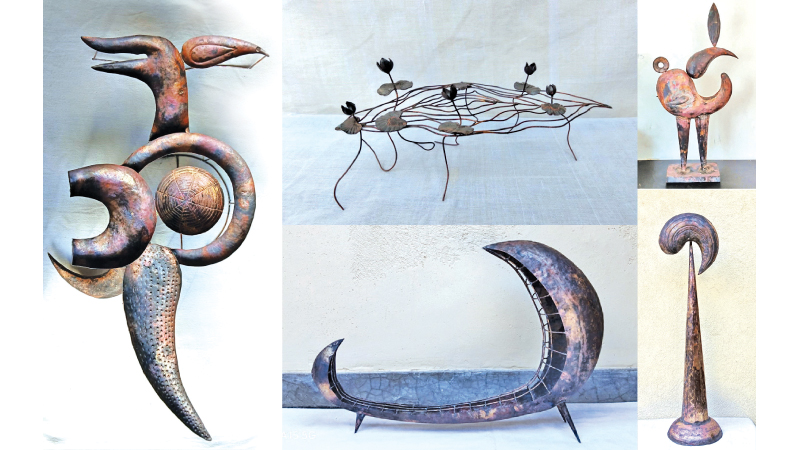 Ever wondered what stories a sheet of copper can tell? At “Mindscapes,” now displayed at the Barefoot Gallery, artist V. Vimal invites us to find out.
Ever wondered what stories a sheet of copper can tell? At “Mindscapes,” now displayed at the Barefoot Gallery, artist V. Vimal invites us to find out.
We recently caught up with Vimal to chat about this latest series, a joint exhibition with artist T. Krishnapriya, and uncover how he transforms raw metal into a canvas of powerful emotions and hidden histories.
Here’s what we found out.
Q: Why is copper a convenient medium for you? What qualities does it have that make it suitable for expressing complex themes such as violence, emotion, and body?
A: Since I work as a jewellery designer in Kolar, I am familiar with manipulating this medium — such as shaping a form, embossing, surface preparation, and joining techniques. I apply these same technical skills in sculpture as well. This medium serves as a powerful outlet for expressing my emotions.
For example, just as human skin has a limited capacity to endure — it tears or gets damaged when subjected to excessive pressure — copper too has similar characteristics. If struck or heated beyond its tolerance, it tears or melts. In the human body, acts of violence can take many forms of abuse.
Similarly, in sculpture, bringing out a form involves processes such as cutting, heating, hammering, and joining the material. By leaving the joined scars unpolished, I allow the raw marks and the natural colour of the copper to reflect the wounds and pain found in human flesh, conveying a deeper emotional resonance.
Q: Your artistic statement talks about the human body being more than just flesh and blood, but also feelings and culture. Using a material sicj as copper which is rigid and strong, it should be a tough process to give a life. How do you show these invisible parts of the body in your physical artworks?
A: Violent individuals often mislead people for their own personal gain, promote violence, and use power to oppress, destroy, and demean a community. In such instances, their only thought is to eliminate those who stand in their way.
They do not feel the weight of the fact that the community they are harming has a history spanning several centuries, with its own distinct culture and way of life — all of which are being lost. Copper has been a long-used material in our society. Its usage declined due to the arrival of new materials and the effects of war.
The artisans who once produced and crafted it no longer exist. Many of our historical records and archaeological evidence are documented in this medium. Here, the material is not merely functioning as a medium — it is tied to history itself. In my approach to sculpture, I express this connection through simplification, symbols, movement, depth, and characteristics of serialism.
Q: You treat metal with cutting, heating, hammering, and blending. Can you describe how each of these actions helps you represent the pain and trauma caused by violence?
A: When a body is subjected to violence, the perpetrators inflict various forms of torment —beating, cutting, burning, tearing. As a result, the body suffers injuries, becomes deformed, and transforms into something grotesque. This psychologically impacts the human mind. When I use such a process in the act of creating sculpture, I too transfer that violence onto the medium.
Through processes such as hitting, cutting, shaping the surface, heating, and attaching, my emotions are transferred into it. For a creation to come into existence, it must undergo and absorb all kinds of processes creatively. In the end, I believe that the final artwork conveys this to the viewer as well.
Q: When you transfer your fear into an artistic creation, you realize a “temporary” feeling. Can you explain what you mean by this temporary feeling? What happens after that for you as the artist?
A: . When an artist creates a sculpture, the emotions within him are expressed through the creation. This is because when emotions are transformed into art, the mind, from a psychological perspective, finds temporary relief from its internal struggles and attains a sense of peace. However, this peace is only temporary.
This is because there is no permanent solution to the problems rooted in our society. When violence once again gives rise to problems, the mind returns to its previous state. Therefore, true and lasting peace does not exist here. An artist can never attain complete peace.
Q: You mentioned expressing yourself through similes and metaphors, distortions and blending of shapes. Can you give us an example of how you use these techniques in a piece to say something you “cannot say” with words?
A: The problems we face today are not direct; they are carried out against us in subtle, indirect ways. Here, all evidence is hidden. Everything we possess is being destroyed without our knowledge. We are not even given the right to question it, and justice is not on our side.
By understanding this through personal experiences, literature, and history, the stories and characters within them constantly remind me of my own struggles. When I transform this into a creative expression, I am not merely narrating their stories — I am transforming my own emotions into a creative form.
For this, I use elevated forms, surface-level and surrealist elements, and combine depth with multiple forms. This combination speaks to a social construct, because society is not a singular entity — it is made up of multiple components. Therefore, the stories here have been rendered formless.








